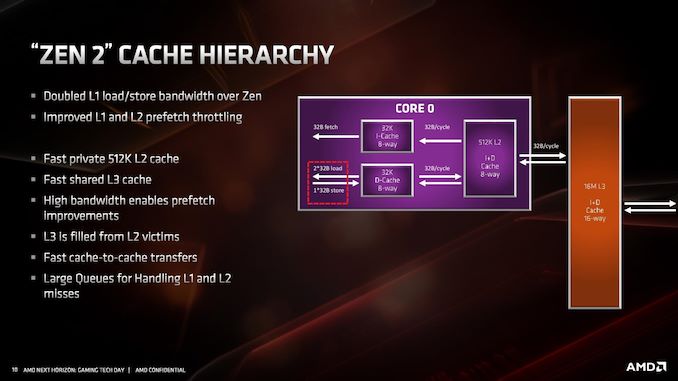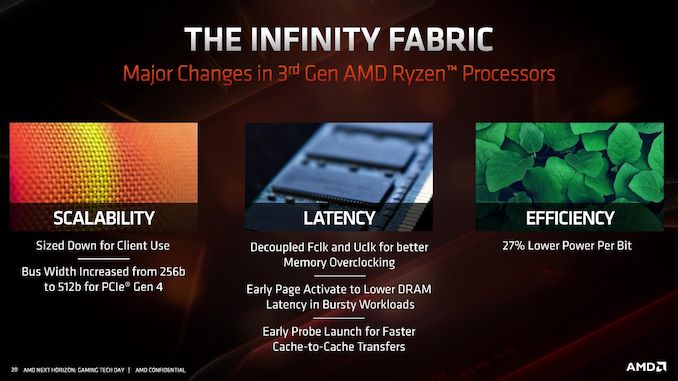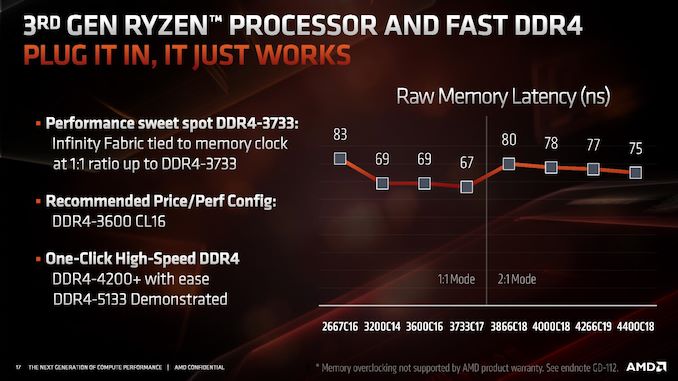AMD Zen 2 Microarchitecture Analysis: Ryzen 3000 and EPYC Rome
by Dr. Ian Cutress on June 10, 2019 7:22 PM EST- Posted in
- CPUs
- AMD
- Ryzen
- EPYC
- Infinity Fabric
- PCIe 4.0
- Zen 2
- Rome
- Ryzen 3000
- Ryzen 3rd Gen
Cache and Infinity Fabric
If it hasn’t been hammered in already, the big change in the cache is the L1 instruction cache which has been reduced from 64 KB to 32 KB, but the associativity has increased from 4-way to 8-way. This change enabled AMD to increase the size of the micro-op cache from 2K entry to 4K entry, and AMD felt that this gave a better performance balance with how modern workloads are evolving.
The L1-D cache is still 32KB 8-way, while the L2 cache is still 512KB 8-way. The L3 cache, which is a non-inclusive cache (compared to the L2 inclusive cache), has now doubled in size to 16 MB per core complex, up from 8 MB. AMD manages its L3 by sharing a 16MB block per CCX, rather than enabling access to any L3 from any core.
Because of the increase in size of the L3, latency has increased slightly. L1 is still 4-cycle, L2 is still 12-cycle, but L3 has increased from ~35 cycle to ~40 cycle (this is a characteristic of larger caches, they end up being slightly slower latency; it’s an interesting trade off to measure). AMD has stated that it has increased the size of the queues handling L1 and L2 misses, although hasn’t elaborated as to how big they now are.
Infinity Fabric
With the move to Zen 2, we also move to the second generation of Infinity Fabric. One of the major updates with IF2 is the support of PCIe 4.0, and thus the increase of the bus width from 256-bit to 512-bit.
Overall efficiency of IF2 has improved 27% according to AMD, leading to a lower power per bit. As we move to more IF links in EPYC, this will become very important as data is transferred from chiplet to IO die.
One of the features of IF2 is that the clock has been decoupled from the main DRAM clock. In Zen and Zen+, the IF frequency was coupled to the DRAM frequency, which led to some interesting scenarios where the memory could go a lot faster but the limitations in the IF meant that they were both limited by the lock-step nature of the clock. For Zen 2, AMD has introduced ratios to the IF2, enabling a 1:1 normal ratio or a 2:1 ratio that reduces the IF2 clock in half.
This ratio should automatically come into play around DDR4-3600 or DDR4-3800, but it does mean that IF2 clock does reduce in half, which has a knock on effect with respect to bandwidth. It should be noted that even if the DRAM frequency is high, having a slower IF frequency will likely limit the raw performance gain from that faster memory. AMD recommends keeping the ratio at a 1:1 around DDR4-3600, and instead optimizing sub-timings at that speed.













216 Comments
View All Comments
jamescox - Saturday, June 22, 2019 - link
You seem to just be trying to spread FUD. Also, you don’t seem to know how long a nanosecond is. The CCX to CCX latency can cause slower performance for some badly written or or badly optimized multithreaded code, but it is on such a fine scale that it would just effect the average frame rate. It isn’t going to cause stuttering as you describe.The stuttering you describe could be caused by a huge number of things. It could be the gpu or cpu thermally throttling due to inadequate cooling. If the gpu utilization goes down low, that could be due to the game using more memory than the gpu has available. That will slow to a crawl while assets are loaded across the pci express bus. So, if anyone is actually having this problem, check your temperatures, check your memory usage (both cpu and gpu), then maybe look for driver / OS issues.
playtech1 - Wednesday, June 12, 2019 - link
Good products and good prices.Knock-out blow though? I don't think so for the consumer and gaming space, as I can buy a 9900 today for a fairly small premium over the price of a 3800x and get basically the same performance.
The 12 and 16 core chips look more difficult for Intel to respond to though, given how expensive its HEDT line is (and I say that as an owner of a 7860x).
Atari2600 - Wednesday, June 12, 2019 - link
Yeah, power and thermals are not so important in consumer/game space.In server/HPC, Intel is in deep crap.
Phynaz - Wednesday, June 12, 2019 - link
Bahahaha. No.eva02langley - Thursday, June 13, 2019 - link
Phhh... are you ban from WCCFtech?Gastec - Wednesday, June 19, 2019 - link
I guess I'm neither consumer nor gamer with my i7-860 and GTX 670, G502, G110 and G13. I bought the Logitech G13 just to type better comments on Tweeter :PGastec - Wednesday, June 19, 2019 - link
I also turn OFF RGB whenever I can, anti-cosumerism and anti-social is written on my forehead and everyone is pointing at me on the woke streets.just4U - Thursday, June 13, 2019 - link
I'd say it's a substantial blow to Intel. One of the reasons I picked up a 2700x was the cooler, which is pretty damn good overall.. and the buy in was substantially lower. The 3700x-3800x will only add to that incentive with increased performance (most will likely not even notice..)Drop in the 12-16 core processors (provided there are no tradeoffs for those additional cores..) make the 9900k unappealing on all fronts. The 9700K was a totally unappealing product with it's 8c/8t package..already and after this launch won't make sense at all.
Gastec - Thursday, June 20, 2019 - link
Core i9-9900 I presume. Nowhere to be found for sale in Mordor. Only found one on Amazon.com for $439.99 reduced from $524.95, sold by "Intel" whomever that scammer is.Hamza12786 - Thursday, June 13, 2019 - link
I Like This Site.Also Checkout<a href"https://www.khanzadatech.com/2019/05/zong-unlimite... Unlimited Free Internet</a>